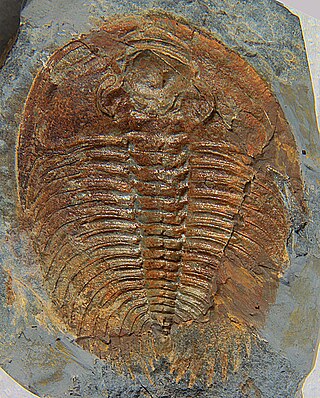
Olenellus is an extinct genus of redlichiid trilobites, with species of average size. It lived during the Botomian and Toyonian stages (Olenellus-zone), 522 to 510 million years ago, in what is currently North-America, part of the palaeocontinent Laurentia.

Acimetopus Rasetti, 1966, is a genus of Eodiscinid trilobite belonging to the family Weymouthiidae Kobayashi (1943), Order Agnostida Salter (1864). It lived during the Botomian stage. = late Lower Cambrian Stage 4 ; the upper Botomian boundary corresponds to base of the Middle Cambrian, Miaolingian Series and Wuliuan stage.
Laudonia is an extinct genus of trilobites that lived during the early part of the Botomian stage, which lasted from approximately 524 to 518.5 million years ago. This faunal stage was part of the Cambrian Period. There are currently two named species assigned to it.

Mummaspis is an extinct genus from a well-known class of fossil marine arthropods, the trilobites, with five known species. It lived during the early part of the Botomian stage, which lasted from approximately 524 to 518.5 million years ago. This faunal stage was part of the Cambrian Period.

Wills Creek Formation is a mapped Silurian bedrock unit in Pennsylvania, Maryland, Virginia, and West Virginia.

Wanneria is an extinct genus from a well-known class of fossil marine arthropods, the trilobites. It lived during the later part of the Botomian stage, which lasted from approximately 524 to 518.5 million years ago. This faunal stage was part of the Cambrian Period. Wanneria walcottana is the only known species in this genus.

Salterella is an enigmatic Cambrian genus with a small, conical, calcareous shell that appears to be septate, but is rather filled with stratified laminar deposits. The shell contains grains of sediment, which are obtained selectively by a manner also observed in foramanifera. The genus was established by Elkanah Billings in 1861, and was named after the English palaeontologist John William Salter.
The Mount Cap Formation is a geologic formation exposed in the Mackenzie Mountains, northern Canada. It was deposited in a shallow shelf setting in the late Early Cambrian, and contains an array of Burgess Shale-type microfossils that have been recovered by acid maceration.

The Tonto Group is a name for an assemblage of related sedimentary strata, collectively known by geologists as a Group, that comprises the basal sequence Paleozoic strata exposed in the sides of the Grand Canyon. As currently defined, the Tonto groups consists of the Sixtymile Formation, Tapeats Sandstone, Bright Angel Shale, Muav Limestone, and Frenchman Mountain Dolostone. Historically, it included only the Tapeats Sandstone, Bright Angel Shale, and Muav Limestone. Because these units are defined by lithology and three of them interfinger and intergrade laterally, they lack the simple layer cake geology as they are typically portrayed as having and geological mapping of them is complicated.

The Muav Limestone is a Cambrian geologic formation within the 5-member Tonto Group. It is a thin-bedded, gray, medium to fine-grained, mottled dolomite; coarse- to medium-grained, grayish-white, sandy dolomite and grayish-white, mottled, fine-grained limestone. It also contains beds of shale and intraformational conglomerate. The beds of the Muav Limestone are either structureless or exhibit horizontally laminations and cross-stratification. The Muav Limestone forms cliffs or small ledges that weather a dark gray or rusty-orange color. These cliffs or small ledges directly overlie the sloping surfaces of the Bright Angel Shale. The thickness of this formation decreases eastward from 250 feet (76 m) in the western Grand Canyon to 45 feet (14 m) in the eastern Grand Canyon. To the west in southern Nevada, its thickness increases to 830 feet (250 m) in the Frenchman Mountain region.

Bristolia is an extinct genus of trilobite, fossil marine arthropods, with eight or more small to average size species. It is common in and limited to the Lower Cambrian shelf deposits across the southwestern US, which constitutes part of the former paleocontinent of Laurentia.
The Shady Dolomite is a geologic formation composed of marine sedimentary rocks of early Cambrian age. It outcrops along the eastern margin of the Blue Ridge province in the southeastern United States and can be found in outcrops in the states of Alabama, Georgia, Tennessee, North Carolina, and Virginia. It can also be found in the subsurface of Kentucky, Ohio, and West Virginia. The Shady is predominantly composed of dolomite and limestone with lesser amounts of mudrock. It contains fossils of trilobites, archaeocyathids, algae, brachiopods, and echinoderms, along with the enigmatic fossil Salterella. The Shady Dolomite was first described by Arthur Keith in 1903 and was named for exposures in the Shady Valley of Johnson County in the state of Tennessee. Near Austinville, Virginia, the Shady hosts ore deposits that have been mined extensively for lead and zinc ore.

The Vintage Dolomite is a geologic formation in Pennsylvania. It preserves fossils dating back to the Cambrian period.
The West Castleton Formation is a geologic formation in New York and Vermont. It preserves fossils dating back to the Cambrian period.
The Forteau Formation is a geologic formation in Newfoundland and Labrador. It preserves fossils dating back to the Cambrian period.
The Sekwi Formation is a geologic formation in Northwest Territories, Canada, which preserves fossils dating back to the Cambrian period.
The Illtyd Formation is an up to 1000-m thick geologic formation in Yukon. It preserves fossils dating back to the Dyerian subdivision of the Cambrian period, which spans the Stage 3 / Stage 4 boundary; it's considered to belong to the mid-upper Bonnia-Olenellus trilobite Zone. Top of the unit corresponds, more or less, to the top of Stage 4. These fossils include Lower Cambrian trilobites'.
The Mount Whyte Formation is a stratigraphic unit that is present on the western edge of the Western Canada Sedimentary Basin in the southern Canadian Rockies and the adjacent southwestern Alberta plains. It was deposited during Middle Cambrian time and consists of shale interbedded with other siliciclastic rock types and limestones. It was named for Mount Whyte in Banff National Park by Charles Doolittle Walcott, the discoverer of the Burgess shale fossils, and it includes several genera of fossil trilobites.
The Hells Mouth Grits, formally defined and renamed the Hells Mouth Formation by Young et al., is a geological formation composed of Cambrian Greywackes in the south west part of St. Tudwal's Peninsula. Equivalent to the Rhinog Formation in the Harlech Dome, the grit beds exposed at St Tudwal's are very uniform in lithology and thickness when traced along the outcrops, with a gradual thinning southwards. They exhibit the characteristic textures and structures of greywackes but differ from the normal type in being relatively well sorted and commonly laminated. Intercalated mudstones are more variable both in thickness and in lithology and contain laminated mudstones rich in sponge remains. The sandstones have sharply defined bases, often bearing sole structures and occasionally loaded. Sandstone dykes cut down from the bases of some beds and extend through up to 0.6 m of underlying siltstones. The sandstones may form sheets up to 4 m thick, although a bed thickness of up to 1m is more usual, and have been interpreted as turbidites deposited by currents from the northeast.
Yorkicystis is a genus of edrioasteroid echinoderm that lived 510 million years ago in the Cambrian aged Kinzers Formation in what is now Pennsylvania. This genus is important as it provides some of the oldest evidence of echinoderms losing their hard mineralized outer skeletons. Yorkicystis also shows that some echinoderms lost their skeletons during the Cambrian, which is a greatly different time as to when most other species lost theirs.













